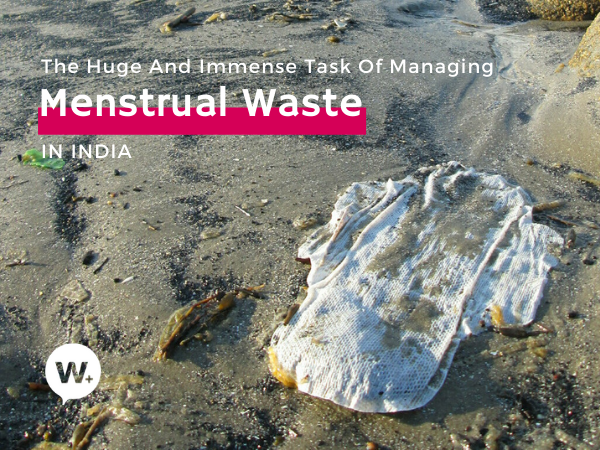Sanitary waste disposal has become an emerging problem in India as the plastic used in disposable sanitary napkins is not bio-degradable and can lead to health and environmental risks. The consequences are more noticeable because of the unorganised ways of municipal solid waste management. As per, the Menstrual Hygiene Alliance of India (MHAI), 36 per cent of the total 336 million menstruating women in India, uses on an average of 8 disposable sanitary napkins during each menstrual cycle. This implies that India has 12.3 billion disposable sanitary napkins to take care of every year, majority of which are not biodegradable/compostable.
Since 2000, India’s legislations on SWM (Solid Waste Management) have been in place and pertinent changes have been made in comparison of SWM Rules 2016 where, soiled napkins, diapers, condoms, tampons and blood-soaked cotton are considered household waste and are being disposed after segregation into biodegradable and non-biodegradable components. The changes accommodate existing disposal technologies, composting, strengthening capacities of urban local bodies for segregation, recycling and reuse of waste.
‘CLEAN INDIA and ‘MENSTRUAL WASTE CLASSIFICATION’
While the ministries of Women and Child Development and Human Resources have taken various initiatives in breaking the silence and stigma around menstruation by enabling environment for girls and women to access the essential healthcare products, by enhancing their level of awareness on menstrual hygiene; but a topic that continues to remain under wraps is ‘the issue of menstrual waste management’.
Ideally waste management solutions should be according to type of products being used. The challenge lies with the disposable sanitary napkins — the vast majority of which are made with non-compostable plastic liner, non-woven cover, and SAPs (Super Absorbent Polymer). The non-compostable has two varieties of sanitary napkins — with SAP and those without.
CLASSIFICATION OF MENSTRUAL WASTE
As per 2016 findings, it is found that there are variations in the way girls manage used menstrual hygiene products. This immediately raises the issue of sustainable waste management of these products, as each has an adverse impact on the environment. Using an interactive waste loading model developed by the global health non-profit, PATH, it is estimated that over 1 billion non-compostable sanitary pads are making their way to urban sewage systems, landfills, rural fields and water bodies in India every month. Further, these products take hundreds of years to decompose, but because of the SAP present in commercial sanitary napkins, they absorb and retain 30 or more times their weight in fluid. This often leads to clogging of toilets, sewage systems and drains, and when burned they release toxic fumes like dioxins and furans that are harmful to people and the environment.
According to the MHAI, three main concerns related to non-compostable menstrual waste in India are –
- Lack of appropriate disposal and treatment options leading to unsafe management of the waste.
- Many girls and women don’t have adequate access to those waste management alternatives that prevail due to their limited ability to negotiate for solutions because of a continued culture of silence associated with menstruation.
- Lack of access to disposal options may lead girls and women using otherwise hygienic products in an unhygienic manner (e.g., use a pad for longer than it should be).
SWM Rules 2016 suggest that all menstrual waste should be sent to one of the 215 large scale common bio-medical waste incinerators that exist across the country. However, this requires organised segregation, collection and transportation of menstrual and other sanitary waste on a large scale. No viable models for this have been formulated or implemented till now.
IMPACT ON THE ENVIRONMENT
There are two decentralised methods for management of menstrual waste — small scale incineration and composting and both can be done for disposable pads without SAP.
Composting is ideal for compostable pads. However, effective composting requires community mobilisation and mechanisms for segregation and aggregation of the waste at community or household level. All this is not easy practically until segregation guidelines are fully implemented menstrual waste will potentially keep polluting soil and water.
Since menstrual waste is handled and treated as solid waste, a series of steps are supposed to be followed. First, segregation and immediate disposal should be done by the user. Solid waste solution should be selected in accordance with the products disposed. And for compostable products there should be clear labelling on product packages providing instructions on disposal.
Also, the paucity of disposal and treatment options may lead to the unsafe management of a mounting volume of menstrual waste.
CURRENT DISPOSAL MECHANISM
In the waste-to-energy technology incinerators the waste generates energy/electricity. Combustion happens in highly controlled environments carefully regulating temperature and pressure, potentially controlling emissions even at low temperatures. Innovations in waste to energy incinerators for community and institutional use are underway. These can incinerate all types of napkins.
The disadvantage is that very few waste to energy plants exist in the country. Those that do operate at a large scale are at select locations.
Hence, the only way to get menstrual waste disposed of safely and efficiently, requires collective attention to this massive environmental health issue. Also, the Ministry of Drinking Water and Sanitation along with the Ministry of Environment and Forests and Climate Change, Ministry of Housing and Urban Affairs efforts should be directed to offer safe and appropriate waste management solutions.






,